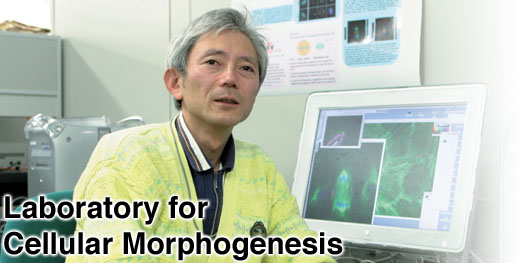




     |

The body's cells exhibit a variety of shapes, a diversity that reflects the truism that form is at least a partial determinant of function. Cells' interiors contain networks of protein polymers called cytoskeletons. Although these structures are thought to play a major role in cellular morphogenesis responsive to changes in the cell's environment, there are still a number of unresolved questions regarding the mechanisms underlying cytoskeletal regulation. We address this issue taking an advantage of imaging techniques, such as fluorescence and electron microscopy, including methods developed by our lab.
Rho family proteins are known to be essential for actin cytoskeleton organization and cell division, but only very limited information about their behavior within cells had been available. We developed an antibody and fixation protocol for capable of localizing Rho and have now begun to use it to elucidate the distribution of Rho in cells and tissues. Animal cells cleave by forming a furrow between the two daughter nuclei following nuclear division. We have found that Rho accumulates at the putative furrow region in a microtubule-dependent manner prior to the initiation of furrowing. This is the first evidence that Rho localization is regulated by microtubules. Further, we have determined the signaling pathway connecting microtubules and Rho by knocking down a number of microtubule-associated proteins. Regulation by Rho appears also to be deeply involved in the determination of the cell division plane.
Cell-cell junction structures associated with actin filaments called adherens junctions are commonly found between adjacent cells in an epithelial sheet. Actin filaments are able to generate tension by interaction with a motor protein, myosin, and the general importance of actin association in the formation of the adherens junction has gained increasing acceptance, but we still do not know the specific reason why actin filaments are so indispensable. We have recently found that in fibroblastic NRK cells the adherens junction forms only at certain tension levels. Without the right amount of tension, adhesion molecules and associated proteins disengage and disperse. Rho activity was found to be involved in this junction formation, and another junction associated protein, vinculin, accumulated in a tension-dependent fashion in epithelial cells, suggesting not only that tension can be transmitted from cell to cell across the adherens junction but that it is also required for proper junction formation.